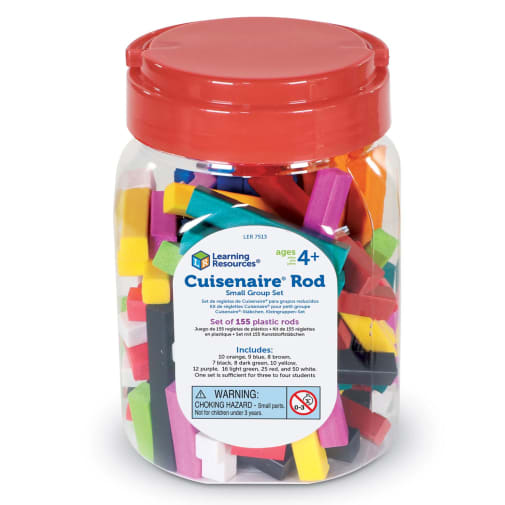Set is stored in a clear plastic tub with lid: 50 white, 25 red, 16 light green, 12 purple, 10 yellow, 8 dark green, 7 black, 8 brown, 9 blue and 10 orange.
Cuisenaire Rods - 155 plastic rods
- Small parts. Not for children under 3 years.
Description
Math is not just numbers! Using Cuisenaire rods, Miquon Math Labs allows children to model numbers and operations concretely. It uses a hands-on, pattern-building, discovery method that fosters independence and creativity in problem solving. The unique page-numbering format of the program allows for flexibility - use each book straight through, covering a variety of topics, or use only the pages in each book relating to a specific topic (easily identified by the alpha-numeric page numbering system).
Instead of holding off on more difficult math topics until later grades, the Miquon approach is unique in teaching all four basic math operations in Grade 1 - plus fractions, clock arithmetic, area, volume and factoring. This builds confidence in children as they see how the basic operations are intterrelated and takes the "mystery" out of these otherwise-delayed topics. By Grade 3, children understand different base systems and graph algebraic equations!
These are not typical workbooks that test what a child already has learned, but lab sheets - teaching pages. Children are shown that, while there is only one correct solution, there are different ways to arrive at it, and it encourages them to develop their own techniques. The "standard" approach is not always the best. For example, which is easier, to teach borrowing and carrying for a problem like 400 - 298 or to teach the the child to restate the problem as 398 - 298 + 2 or 400 - 300 + 2? Techniques like these really help to develop mental dexterity in problme solving. After using Miquon with our seven children, we can attest that this program has promoted flexibility in problem solving and teaches them to find the best technique for the situation. Ours students now tackle new or difficult problems creatively, even fearlessly!
Altogether, the six student workbooks contain over 650 lab sheets. Concepts covered include: counting, odd-even, addition, subtraction, multiplication, division, fractions, equalities, place value, number line and functions, factoring, squaring, simultaneous equations, graphing equations, geometric recognition, length, area, volume, series and progressions, grid and arrow games, mapping, clock arithmetic, sets, and word problems.
We recommend purchasing the Lab Sheet Annotations. This is the teacher's guide for all six workbooks. Because the approach taken in the program is so different, it explains the reasoning behind the presentation and provides several suggestions on how to present each topic. It also provides preliminary activities for a concrete understanding of the math concepts as well as more detailed explanations for many of the workbook pages. While answers are supplied for some of the more "tricky" sheets, most worksheets are shown sans answers, so take the time to fill in the answers as you correct work for your first Miquon student - then you'll have a completed key to use with the next!
The Miquon Math program would be an excellent start in math to move into any other program, but it would lend itself particularly well to those intending to use the Singapore approach to math in the future.
| Product Format: | Other |
|---|---|
| Grades: | PK-8 |
| Brand: | Cuisenaire |
| EAN/UPC: | 765023075137 |
| Length in Inches: | 4.25 |
| Width in Inches: | 4.25 |
| Height in Inches: | 6.25 |
| Weight in Pounds: | 1.038 |

